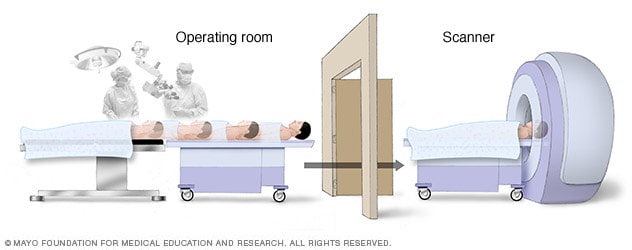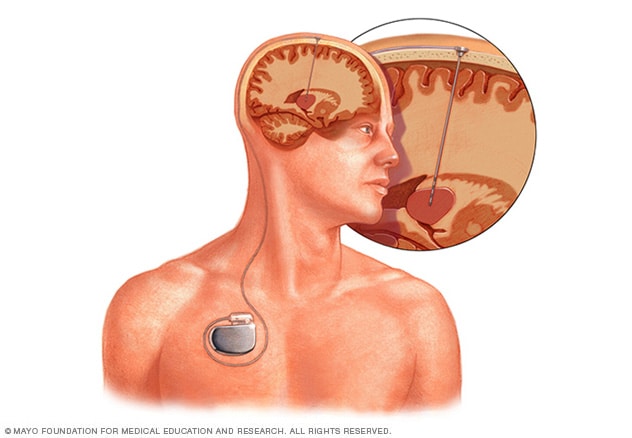نظرة عامة
التصوير بالرنين المغناطيسي أثناء العملية

التصوير بالرنين المغناطيسي أثناء العملية
بما أن الدماغ يمكنه التحرك خلال العملية الجراحية، تُستخدم تقنيات رسم خرائط الدماغ والتصوير بالرنين المغناطيسي أثناء العملية لإنشاء صور دقيقة للدماغ.
وتوجِّه هذه الصور جراحَ الأعصاب ليتمكن من استئصال النسيج الذي يجب استئصاله فقط والتركيز على المنطقة المستهدفة للعلاج.
وهذا يُجنِّب جراح الأعصاب المساسَ بالأنسجة الوظيفية في الدماغ.
وهذا يساعد على الحفاظ على الوظيفة الحركية واللغوية وغيرهما من وظائف الدماغ المهمة.
في جراحات الدماغ بمساعدة الحاسوب، يستخدم الجراحون تقنيات التصوير لإنشاء نموذج ثلاثي الأبعاد للدماغ.
قد تشمل الفحوصات التصويرية التصوير بالرنين المغناطيسي (MRI) والتصوير بالرنين المغناطيسي أثناء العملية والتصوير المقطعي المحوسب (CT) والتصوير المقطعي بالإصدار البوزيتروني (PET).
تسمح برامج الدمج التخصصية باستخدام أنواع متعددة من التصوير.
يمكن إجراء التصوير قبل الجراحة وأحيانًا يُجرى أثناء الجراحة.
يسمح هذا النموذج لجرَّاح الدماغ، ويُعرف باسم جرَّاح الأعصاب، بالتخطيط للطريقة الأكثر أمانًا لعلاج حالتك التي تحتاج إلى جراحة.
أثناء الجراحة، يوجه نظام الحاسوب الجرَّاح بدقة إلى المنطقة التي يجري علاجها في الدماغ.
لماذا يتم إجراء ذلك
التحفيز العميق للدماغ

التحفيز العميق للدماغ
يتضمن التحفيز العميق للدماغ زرع قطب كهربي في جزء عميق من الدماغ. ويُضبط مقدار التحفيز الذي يوصله القطب الكهربي باستخدام جهاز مثبت تحت الجلد في منطقة الصدر. ويتصل الجهاز بالقطب الكهربي عن طريق سلك يمر تحت الجلد.
تُستخدم جراحة الدماغ بمساعدة الحاسوب لعلاج مجموعة متنوعة من الحالات التي تؤثر في الدماغ.
تشمل الحالات أورام الدماغ وداء باركينسون والرُّعاش مجهول السبب والصرع والتشوهات الشريانية الوريدية.
إذا كنت مصابًا بورم في الدماغ، فقد يجمع الجراح بين الجراحة بمساعدة الحاسوب وجراحة الدماغ أثناء اليقظة.
يستخدم جراحو الأعصاب أيضًا تقنيات بمساعدة الحاسوب عند استخدام حزم إشعاعية مركزة بدقة، في ما يُعرف باسم الجراحة الإشعاعية التجسيمية.
قد تُستخدَم الجراحة الإشعاعية التجسيمية لعلاج أورام الدماغ والتشوهات الشريانية الوريدية وألم العصب ثلاثي التوائم وغير ذلك من الحالات المرضية.
ويمكن استخدام الجراحة بمساعدة الحاسوب عند زرع أقطاب كهربائية للتنبيه العميق للدماغ أو التنبيه العصبي المستجيب.
قد يستخدم الجراحون التصوير بالرنين المغناطيسي أو التصوير المقطعي المحوسب -أو في بعض الأحيان كليهما- للمساعدة على رسم خريطة دماغك وتخطيط مواضع الأقطاب الكهربائية.
يمكن إجراء ذلك إذا كنت مصابًا بالرُّعاش مجهول السبب أو داء باركينسون أو الصرع أو خلل التوتر العضلي أو اضطراب الوسواس القهري.
المخاطر
تساعد جراحة الدماغ بمساعدة الحاسوب على خفض مخاطر العمليات الجراحية.
فعند إنشاء نموذج ثلاثي الأبعاد لدماغك، يمكن لجراح الأعصاب تخطيط الطريقة الأكثر أمانًا لعلاج حالتك.
كما يُستعان بالحاسوب لتوجيه الجراح إلى المناطق المستهدفة بالضبط في الدماغ التي تتطلب العلاج.
ورغم ذلك، لا تخلو أي جراحة من وجود بعض المخاطر.
تتميز الجراحة الإشعاعية التجسيمية بانخفاض مخاطرها، وغالبًا ما تكون الآثار الجانبية المحتملة مؤقتة.
ومنها الشعور بالتعب الشديد، بالإضافة إلى ألم وتورم في منطقة العلاج.
وقد تشمل الآثار الجانبية أيضًا تهيج فروة الرأس.
ونادرًا ما قد تحدث تغيرات في الدماغ بعد عدة أشهر من الجراحة.
ينطوي التنبيه الدماغي العميق على بعض المخاطر أيضًا، منها التعرض للعدوى والنزيف ونوبات الصرع والسكتة الدماغية.
إذا تمت إزالة جزء من الجمجمة لإجراء الجراحة، فتشمل المخاطر المحتملة النزيف أو التورم أو العدوى.
كيف تستعد؟
اتبع تعليمات فريق الرعاية الصحية بشأن الإجراءات الواجب اتخاذها في الأيام والساعات التي تسبق جراحة الدماغ.
قد تحتاج إلى التوقف عن تناول بعض الأدوية قبل الجراحة.
على سبيل المثال، الأدوية المضادة لتخثر الدم تبطئ عملية تجلط الدم.
وقد تزيد هذه الأدوية خطر حدوث نزيف.
تحدث إلى فريق الرعاية الصحية حول ما إذا كنت بحاجة إلى التوقف عن تناول الأدوية المضادة لتخثر للدم قبل الجراحة ومدة التوقف.
ما يمكن أن تتوقعه
ما يحدث أثناء جراحة الدماغ بمساعدة الحاسوب يعتمد على نوع الجراحة التي ستخضع لها.
غالبًا ما يتم استخدام دواء يضعك في حالة شبيهة بالنوم، المعروفة باسم التخدير العام، في جراحة الدماغ بمساعدة الحاسوب.
إذا كنت تخضع لجراحة الدماغ أثناء اليقظة، فسيُطلب منك تناول أدوية تجعلك تشعر بالاسترخاء وتمنع الشعور بالألم ولكنك تظل مستيقظًا.
يتيح لك ذلك التفاعل مع فريق الجراحة لتحقيق أقصى قدر من السلامة أثناء إجراء الجراحة.
في بعض الأحيان، يُزال جزء من الجمجمة لإجراء عملية على الدماغ.
أما في العمليات الجراحية الأخرى، مثل الجراحة الإشعاعية التجسيمية، لا يحدث أي قطع.
لكن يُوجه الإشعاع إلى منطقة الدماغ التي تحتاج إلى العلاج.
قد يُجري جراح الأعصاب فحوصات تصويرية أثناء الجراحة، وتعرف باسم التصوير بالرنين المغناطيسي أثناء العملية أو التصوير المقطعي المحوسب باستخدام جهاز تصوير مقطعي محمول.
قد يكون جهاز التصوير المستخدَم لالتقاط الصور موجودًا داخل غرفة العمليات وينقل إليك لإجراء الفحص التصويري.
أو قد يكون في غرفة مجاورة وتنقل إليه لإجراء الفحص.
النتائج
تساعد جراحة الدماغ بمساعدة الحاسوب الجراحين على التخطيط لإجراء العمليات الجراحية على الدماغ وتنفيذها بدقة أكبر.
فعندما تكون جراحة الدماغ أكثر دقة، يؤدي ذلك إلى الحصول على نتائج أفضل ومضاعفات أقل.
يساعد استخدام التصوير أثناء العملية، المعروف باسم التصوير بالرنين المغناطيسي أثناء العملية أو التصوير المقطعي المحوسب، جراحي الأعصاب على مراعاة التغييرات التي تحدث في الدماغ أثناء إجراء العملية الجراحية.
على سبيل المثال، قد يتحرك الدماغ أثناء الجراحة.
ومن ثمَّ، يساعد التصوير أثناء الجراحة على جعل الجراحة أكثر دقة.
كما ينبه التصوير أثناء العملية الجراحين إلى المضاعفات حتى يمكن معالجتها بسرعة.
أظهرت بعض الأبحاث أن استخدام التصوير بالرنين المغناطيسي أثناء العملية يساعد الجراحين على استئصال الورم أو الأنسجة التالفة بشكل كامل.
تسمح جراحة الدماغ بمساعدة الحاسوب أيضًا بالابتعاد عن الأنسجة السليمة مع استهداف الأنسجة الدماغية المراد إجراء الجراحة عليها فقط.